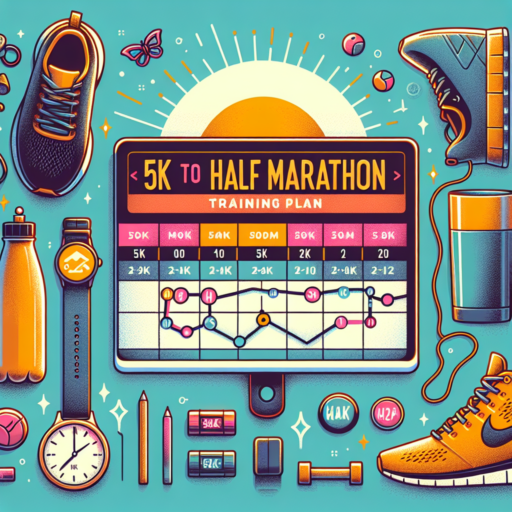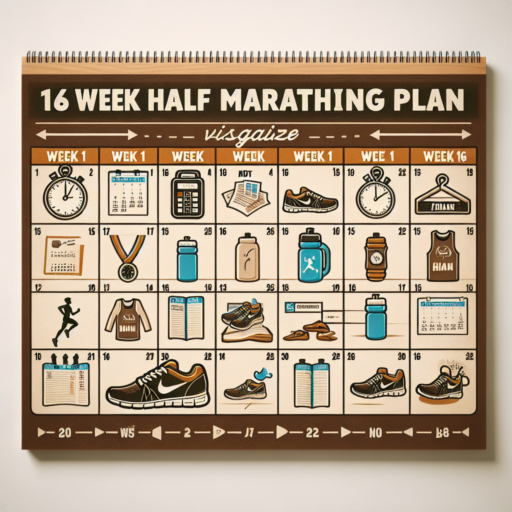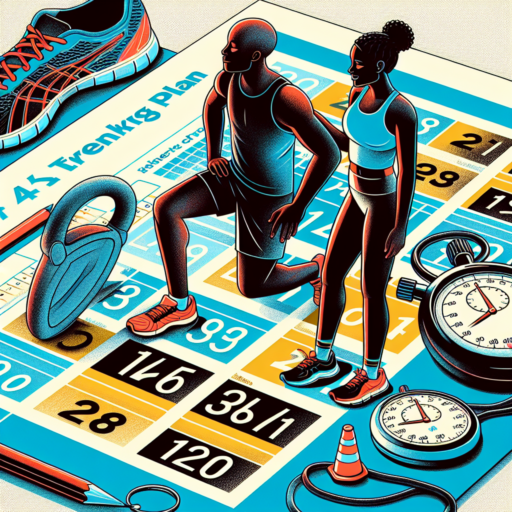Introduction to 5K to Half Marathon Training Plan
Taking the leap from running a 5K to tackling a half marathon is an exciting challenge for any runner. This introductory guide serves as the initial step towards achieving the goal of running 21.1 kilometers. Whether you’re a novice runner who has just tasted the thrill of a 5K race or a seasoned 5K participant looking to push your boundaries, transitioning to a half marathon requires a blend of determination, strategy, and gradual training.
The 5K to Half Marathon Training Plan is designed to bridge the gap between these two significant distances by carefully balancing running and recovery. The essence of this plan lies in its approach to gradually increasing your mileage, allowing your body to adapt to longer distances without the risk of injury. It’s about enhancing your endurance, refining your running technique, and building the mental fortitude necessary for the half marathon challenge.
This guide will offer insights into the core components of the training plan including weekly mileage increases, cross-training sessions, and long runs that are pivotal for half marathon success. Emphasis is placed on the importance of listen
Key Components of a Successful 5K to Half Marathon Transition
Transitioning from running a 5K to completing a half marathon is no small feat. It requires not only physical readiness but also mental preparation and strategic planning. Those who embark on this journey need to understand the core components that contribute to a successful upscaling in distance. By focusing on these key areas, runners can ensure they not only reach the finish line but do so in a way that is both rewarding and sustainable.
Incremental Training Increase
A vital component of any 5K to half marathon transition is the gradual increase in distance. Abrupt increases in your running distance can lead to injury, burnout, or both. Experts recommend following the 10% rule, which advises runners to increase their mileage by no more than 10% each week. This steady approach helps the body adjust to the additional stress, building endurance without overtaxing the system.
Nutrition and Hydration Strategies
As you increase your distance, your body’s needs for fuel and hydration will also escalate. A key success factor in transitioning to longer distances is mastering the art of fueling your body correctly. This includes paying attention to both your pre-run and post-run nutrition, as well as hydrating effectively throughout your training and on race day. Getting this right can mean the difference between a strong finish and a struggle to the end.
Recovery and Cross-Training
Balancing your increased mileage with appropriate rest and recovery is paramount. Incorporating days off and engaging in low-impact cross-training activities such as swimming, cycling, or yoga can enhance your running performance while minimizing injury risks. Additionally, focusing on muscle recovery through methods like foam rolling, massage, or stretching sessions is critical for maintaining a healthy and resilient body ready for the challenges of longer distances.
8-Week Training Schedule for Converting 5K Fitness into Half Marathon Readiness
If you’ve mastered the 5K and are ready to leap into longer races, transforming your running base into half marathon readiness requires a systematic approach over eight weeks. This period allows for a progressive increase in mileage while incorporating essential rest and cross-training days to prevent overuse injuries. Structuring your week effectively is the key to gradually preparing your body for the 13.1 miles of a half marathon.
Initially, your training will look somewhat similar to your 5K regimen, but with added emphasis on increasing long-run distances each week. Typically, you’ll start with a manageable increase from the longest run you were comfortable with during your 5K training. Week by week, you’ll incrementally add mileage, focusing on one long run per week that gradually extends to at least 10 miles. This long run is pivotal, as it prepares your body and mind for the endurance needed for a half marathon.
Incorporating speed work and recovery runs into your training are also crucial components of your 8-week schedule. Speed sessions help improve your cardiovascular efficiency, teaching your body to manage lactic acid more effectively during longer runs. Meanwhile, recovery runs play a significant role in your week, aiding in muscle repair and building your endurance base without additional stress. Implementing one to two days of cross-training—such as swimming, biking, or yoga—can further enhance your strength and flexibility, rounding out your preparation for the half marathon challenge.
Nutrition and Diet: Fueling Your 5K to Half Marathon Journey
Embarking on the journey from a 5K to a half marathon presents exciting challenges and necessitates a calculated approach to nutrition and diet. Fueling your body correctly is not just about eating healthy; it’s about understanding what your body needs to perform and recover effectively at each stage of your training. The right balance of carbohydrates, proteins, and fats, along with proper hydration, plays a pivotal role in enhancing your running performance and stamina.
Carbohydrates: The Primary Fuel Source
Carbohydrates are the main fuel for runners, especially when tackling long distances. They’re stored in your muscles and liver as glycogen and provide the energy required to sustain your pace throughout a race. Integrating a mix of complex carbohydrates like whole grains, fruits, and vegetables in your meals ensures a steady release of energy. Before a run, focusing on simple carbohydrates can offer an immediate energy boost. Remember, timing and portion size are key to maximizing the benefits without feeling sluggish or encountering gastrointestinal distress.
Protein: Essential for Recovery
While carbohydrates are crucial, proteins play an equally necessary role in repairing and building the muscles used during your runs. Consuming adequate protein after your training sessions helps to speed up recovery, allowing your muscles to mend and strengthen. Foods rich in high-quality protein, such as lean meats, fish, dairy, legumes, and nuts, should be staples in your diet. Pairing proteins with carbohydrates post-run can also enhance glycogen replenishment, further aiding in recovery and preparation for your next workout.
Adapting your nutritional intake as you progress from 5K to a half marathon allows your body to cope with the increased demands of training. Listening to your body, staying hydrated, and making informed choices about when and what to eat can significantly impact your performance and enjoyment of the race. With the right nutrition and diet, you not only fuel your runs but also support your overall health and well-being on the path to achieving your racing goals.
Understanding the Physical and Mental Challenges of Moving from 5K to Half Marathon
Transitioning from running 5K races to tackling a half marathon is a significant leap that demands attention to both physical and mental adjustments. This increase in distance not only tests your endurance but also challenges your mental fortitude, pushing your limits beyond the familiar 5,000 meters to an impressive 21,097 meters. It’s a journey that requires a strategic approach to training, nutrition, and mindset.
Physical adaptations are crucial as you embark on this increased distance. The body must adjust to the extended demand for endurance, which means that your training schedule should gradually build in intensity and distance. This helps in enhancing aerobic capacity, strengthening the musculoskeletal system, and avoiding injuries that could set back progress. It’s essential to incorporate a mix of long runs, speed work, and rest days to achieve balanced development and prepare the body for the rigors of a half marathon.
On the mental side, the leap from 5K to half marathon involves overcoming psychological barriers that may arise due to the daunting increase in distance. Developing a strong mental game is equally as important as physical preparation. Techniques such as visualization, goal-setting, and mental resilience training can be invaluable tools for maintaining focus and motivation throughout your training journey. Acknowledging and embracing the discomfort that comes with pushing your limits is a pivotal step in mentally preparing for race day.
In conclusion, understanding and overcoming the physical and mental challenges when moving from a 5K to a half marathon is an exhilarating and rewarding endeavor. It invites runners to explore new horizons of their capabilities, pushing them to new heights of endurance, perseverance, and personal achievement.
Rest and Recovery Strategies for 5K to Half Marathon Athletes
Absolutely, focusing on the optimal rest and recovery strategies is pivotal for athletes training for events ranging from 5K to a Half Marathon. These strategies not only help in enhancing performance but also significantly reduce the risk of injuries. Here, we delve into several effective methods designed to aid athletes in their rest and recovery process.
Importance of Adequate Sleep and Nutrition
Adequate sleep plays a crucial role in the recovery process. Athletes should aim for 7-9 hours of quality sleep per night to allow their bodies to repair and rebuild muscle tissues. During sleep, the body also balances hormones that are essential for muscle recovery and growth. Alongside, nutrition cannot be overlooked. Consuming a diet rich in proteins, healthy fats, and carbohydrates aids in replenishing energy stores and repairing muscles. Hydration with water and electrolytes is equally important to replace lost fluids and support metabolic functions.
Active Recovery and Rest Days
Incorporating active recovery, such as light jogging, swimming, or yoga, can significantly improve flexibility and circulation. This gentle form of exercise helps in expediting the clearing of lactate from the muscles, thus aiding in muscle repair and soreness reduction. Furthermore, scheduling rest days is essential. These are days when the intensity of physical activities is significantly reduced or completely rested, allowing full systemic recovery. It’s during these periods that the body has the opportunity to repair and strengthen itself.
Utilization of Recovery Tools and Techniques
Several recovery tools and techniques can be extraordinarily beneficial for athletes. For instance, foam rolling and deep tissue massages can improve blood circulation, reduce muscle tightness, and enhance flexibility. Additionally, methods such as ice baths or contrast water therapy can help in reducing inflammation and muscle soreness post-intense workouts. Incorporating these recovery tools into regular training routines can markedly improve an athlete’s recovery time and overall performance.
By prioritizing rest and recovery strategies, athletes training for a 5K to Half Marathon can optimize their training outcomes and maintain peak physical condition.
Incorporating Speed Work and Long Runs into Your 5K to Half Marathon Training
Enhancing your performance from 5K to half marathon distances involves a strategic blending of various training techniques. Two pivotal components of an effective training plan are speed work and long runs. Speed work aids in increasing your pace and improving your running efficiency, while long runs build endurance, crucial for maintaining pace over longer distances. Mastering the integration of these elements can transform your running capabilities, setting you up for personal bests in your upcoming races.
Beginning with speed work, it’s essential to understand its role in your training regimen. Speed sessions are designed to improve your VO2 max, teach your body to clear lactic acid more efficiently, and enhance your running economy. Techniques such as intervals, hill sprints, and tempo runs are staples of speed work. For instance, incorporating intervals—one minute of intense running followed by one minute of recovery—can significantly boost your pace. The key is to start moderately and gradually increase the intensity to prevent injury and ensure consistent progress.
On the flipside, long runs are the cornerstone of building endurance. They condition your body to exert effort over extended periods, which is vital for the latter stages of a half marathon. Long runs increase your muscular and cardiovascular strength, teaching your body to efficiently use fat as a fuel source, conserving glycogen. To effectively incorporate long runs into your training, progressively increase your longest run by no more than 10% each week. This gradual adaptation is paramount to achieving the endurance needed for longer races without overtraining.
Essential Gear and Technology for 5K to Half Marathon Training
Training for any long-distance race, from a 5K to a half marathon, requires not just determination and a solid training plan, but also the right equipment. With advancements in technology, there are numerous tools and gear that can help enhance your training experience, improve your performance, and keep you safe. Whether you’re a seasoned runner or a beginner, incorporating these essentials into your regimen can make a significant difference.
Running Shoes and Apparel
At the foundation of any runner’s gear list are the right running shoes and apparel. It’s paramount to choose shoes with proper support, cushioning, and fit to prevent injuries and improve performance. Equally important is selecting breathable, moisture-wicking running apparel to ensure comfort during both training and the race. These basics not only enhance your training but also help in avoiding common running pitfalls like blisters and chafing.
Technology Aids
In today’s world, technology plays a crucial role in optimizing your training. Devices like GPS watches and heart rate monitors offer valuable data about your pace, distance, and heart rate, enabling you to adjust your training in real-time. Additionally, apps and online platforms can provide structured training plans, running tips, and virtual challenges to keep you motivated. Embracing these technological aids can lead to marked improvements in your running efficiency and overall performance.
Common Mistakes to Avoid in Your 5K to Half Marathon Training Plan
Transitioning from a 5K to a half marathon is an exciting challenge that requires careful planning and dedication. However, even the most enthusiastic runners can fall prey to common pitfalls that may hinder their progress and performance. Paying attention to these mistakes and proactively avoiding them is crucial for a successful and enjoyable training journey.
Neglecting Proper Recovery
One of the most common mistakes in transitioning from 5K to half marathon training is underestimating the importance of recovery. Adequate rest, including proper sleep and recovery days, is essential to allow your body to heal and grow stronger. Ignoring this can lead to overtraining, increased risk of injury, and burnout. Incorporating active recovery days and ensuring you get enough sleep every night is critical to avoid this pitfall.
Ignoring Nutrition and Hydration
Another mistake often made is neglecting the role of nutrition and hydration in your training plan. As your training intensity and volume increase, so do your body’s demands for fuel and fluids. Failing to adjust your diet and hydration plan accordingly can result in decreased performance, recovery issues, and even health risks. Focus on maintaining a balanced diet rich in nutrients and hydrating properly before, during, and after your runs.
Overlooking the Importance of Cross-Training
Lastly, failing to incorporate cross-training into your routine can hinder your half marathon success. Cross-training activities like cycling, swimming, or strength training not only break the monotony of running but also reduce the risk of injury by balancing muscle use and enhancing overall fitness. This diversification in your training regimen is key to improving your running performance and achieving your half marathon goals.
No se han encontrado productos.
Planning Your Race Day: Tips for a Successful Half Marathon Finish
Running a half marathon is a significant achievement, and the key to a successful finish lies in meticulous planning. Understanding the nuances of race day can make all the difference, ensuring not only a memorable experience but also setting the stage for an impressive performance. From nutrition strategies to pacing tactics, effective race day planning encompasses a wide array of considerations.
Nutrition and Hydration Strategy
One of the most critical aspects of your race day planning involves nutrition and hydration. Figuring out what to eat before, during, and after the race can significantly impact your energy levels and overall performance. It’s crucial to test your nutrition strategy during your training runs to avoid any unexpected issues. Hydrating properly in the days leading up to the race and having a hydration plan for race day itself is equally important. Remember, your hydration needs will vary based on weather conditions, so plan accordingly.
Pacing and Strategy
Another fundamental aspect of achieving a successful half marathon finish is implementing an effective pacing strategy. Understanding your body’s limits and setting realistic pace goals is essential. Break down the race into smaller, more manageable segments, and consider employing a run-walk strategy if it suits your training and endurance levels. Listening to your body and adjusting your pace as needed can help prevent burnout and maintain energy reserves for a strong finish.




